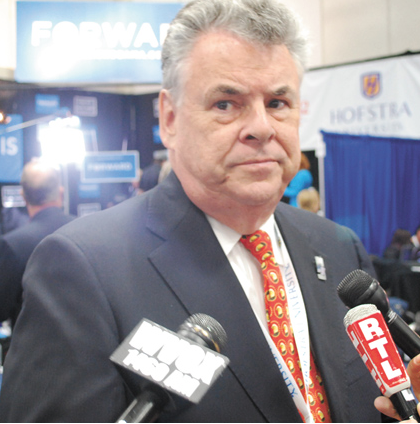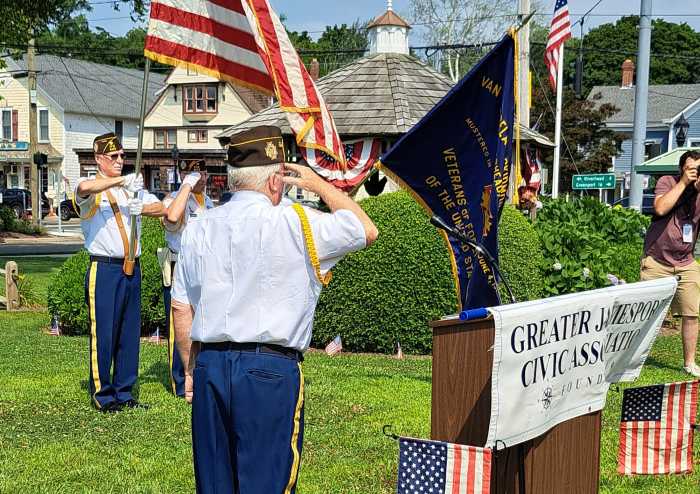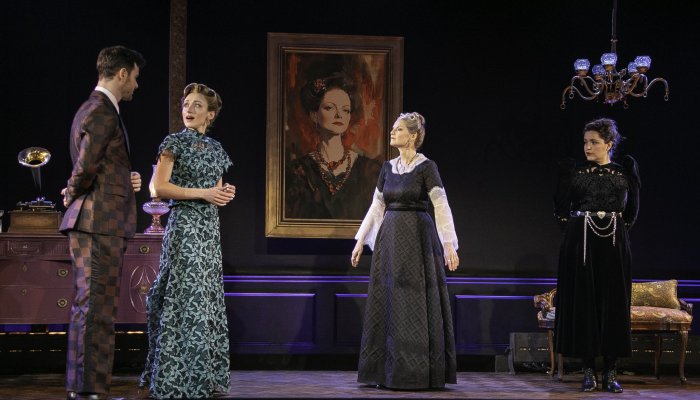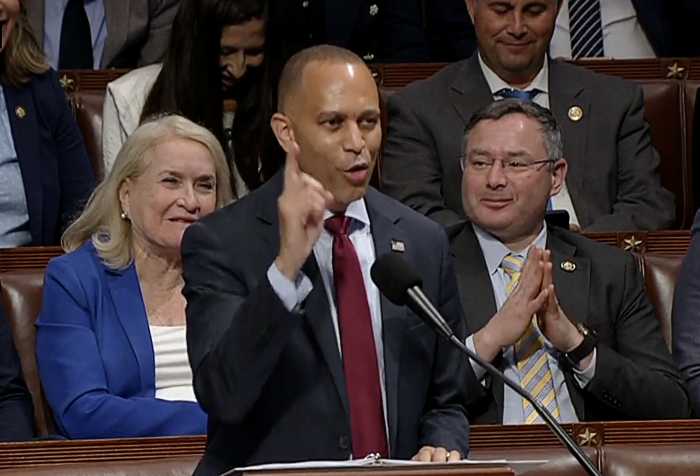The decisions of two grand juries exonerating police officers facing possible murder charges stemming from the deaths of unarmed African-American men in Missouri and New York have cast a harsh light on our country’s judicial system and the state of race relations.
For those who have witnessed the struggles of the civil rights era, it’s déjà vu all over again watching the federal government launch investigations in both Ferguson, Mo., where 18-year-old Michael Brown was shot repeatedly in August by Officer Darren Wilson, and Staten Island, New York, where 43-year-old Eric Garner was choked to death in July by Officer Daniel Pantaleo. In the early 1960s U.S. Attorney General Robert F. Kennedy had to step in and make sure that the legal rights granted to American citizens of all colors were respected, especially down South. Today U.S. Attorney General Eric Holder is doing the same, but in the Midwest and the North.
Defenders of the status quo say that justice was served, protestors say that justice was denied. Congressman Peter King (R-Seaford) went on national TV and said he wanted President Obama to invite Officer Wilson to the White House and congratulate him for doing his job on that hot street in Missouri. Eric Garner’s widow, Esaw Garner, told the media she considered her husband’s death on a New York City sidewalk “a modern day lynching.”
That both grand jury decisions not to indict the officers came almost a week apart added to the righteous anger that has spread across America. The details of the cases do differ, but both prosecutors and the accused cops are white, the victims black. St. Louis County Prosecuting Attorney Bob McCulloch is a Democrat, Richmond County District Attorney Dan Donovan is a Republican. Yet each prosecutor has come under fire for what critics have called a gross miscarriage of justice.
This week’s Garner decision did not sit well with Richard Klein, the distinguished professor of criminal law at Long Island-based Touro Law Center, particularly since the man’s choking death was captured on a cell phone’s video and widely seen.
“This case must raise questions for all of us as to where the justice is for blacks in our criminal justice system,” Professor Klein told the Press. “The chokehold was clearly shown in the video, as was the voice of Eric Garner gasping, ‘I can’t breathe.’ The city’s medical examiner found the death to be a homicide resulting from the chokehold as well as the compression of Garner’s chest by the police officers. The chokehold had been clearly prohibited by the New York City Police Department for the very reason that serious harm could result from its use. It is simply astounding that when we have statutes in New York that specifically encompass a reckless act which leads to a death, the grand jury failed to indict. It is hard to conclude anything other than ‘black lives don’t matter’…at least as far as this Staten Island grand jury was concerned.”
As for the Missouri case, the headline for Washington Post Dana Milbank’s column on the grand jury decision pulled no punches: “Bob McCulloch’s pathetic prosecution of Darren Wilson,” it read. In it, Milbank elaborated, “Ferguson reminds us that we still have a race problem in America. But the face of this problem is not Darren Wilson’s. It’s Bob McCulloch’s.”
Taking the other side of the issue, Rep. Peter King appeared on the Fox Business Network the morning after the grand jury decision and took a unique approach to restoring racial harmony in our troubled nation.
“I think it would be very helpful if President Obama went and met with the police officer, or invited him to the White House and said, ‘You’ve gone through four months of smear and slander, and the least we can do is tell you that it’s unfortunate that it happened and thank you for doing your job,” he told Opening Bell show host Maria Bartiromo. She agreed with him.
But the congressman’s attitude was “very disturbing” to former prosecutor Delores Jones-Brown, now professor of law, police science and criminal justice administration at the City University of New York’s John Jay College of Criminal Justice and founding director of the college’s Center on Crime, Race and Justice in Manhattan.
“When King makes the kind of statement he makes, it shows that he is for whatever reason totally insensitive to the notion that the police should not make it a habit of shooting unarmed civilians, certainly under any kind of circumstances,” she told the Press. “We have developed less than lethal mechanisms for dealing with these situations and part of the reason why we did is that we think it is important for the police not to kill our civilians in the process of allegedly doing their job.”
That the congressman callously ignored what the victims went through—at least in the media spotlight—did not surprise the law professor who had been a prosecuting attorney for three years in New Jersey.

After the grand jury decision regarding Eric Garner, Long Island’s senior Representative then went on CNN’s “Situation Room with Wolf Blitzer” on Wednesday night and apparently blamed the 43-year-old Staten Island married father of six for causing his own death.
“If he had not had asthma and a heart condition and was so obese, almost definitely he would not have died from this,” King observed. “The police had no reason to know that he was in serious condition.”
Garner’s crime at the time was selling loose cigarettes.
Repeated attempts by the Press to ask the Nassau Republican to clarify his remarks about the Ferguson case, especially whether he thought that the prosecutor also deserved a similar invitation to the White House, and to express his opinion on how the Staten Island district attorney had handled his investigation, have fallen on deaf ears. For that matter, neither Suffolk County District Attorney Tom Spota nor Nassau County District Attorney Kathleen Rice, soon to be in Congress herself, cared to comment about either grand jury decision.
Yet as the widespread demonstrations continue to show, there is still a lot to say.
Writing an op-ed titled “Garner Case: Worse Than Ferguson” in the New York Daily News on Dec. 3, Ron Howell, a veteran New York City reporter and now associate professor of journalism at Brooklyn College, said that it was “especially excruciating to watch McCulloch violate all traditions of the grand jury process to obtain and announce Wilson’s exoneration.”
He went on to say that the grand jury process in New York “has in many respects been more suspect than that of Ferguson…We don’t know how cop-friendly Staten Island District Attorney Daniel Donovan has handled the case.”
Howell, a former colleague of mine at New York Newsday, blamed Gov. Andrew Cuomo for ignoring “more than a dozen state lawmakers” who had asked him to appoint a special prosecutor. In Missouri, McCulloch practically dared Gov. Jay Nixon, also a Democrat, to replace him, telling the governor that he could appoint a special prosecutor to handle the Ferguson case but only if he declared a state of emergency first, according to an aide to Congressman William Lacy Clay (D-St. Louis), who represents that district. Nixon caved.
Although McCulloch has repeatedly won re-election since he first entered public office in 1991, the recent protests in Missouri about the Ferguson case were not the first time that he’s faced community opposition. In 2001, the St. Louis Post Dispatch reported, McCulloch refused to prosecute two undercover drug officers who had fired 21 shots killing two unarmed men parked in a car at a Jack in the Box in his county jurisdiction. Protesters threatened to block a local highway after the prosecutor said publicly the victims were “bums.”
As the Ferguson investigation was just getting underway, community activists including Rep. Clay wanted McCulloch to recuse himself because they said they had no confidence in the impartiality of his office. McCulloch was 12 when his father, a St. Louis police officer, was shot and killed by a kidnapper who was African-American. According to the St. Louis Post Dispatch, McCulloch had used his father’s murder as a major campaign theme for his first election. He’d always wanted to become a cop to follow in his father’s footsteps but losing a leg to cancer as a teenager thwarted his career path.
“I couldn’t become a policeman, so being county prosecutor is the next best thing,” McCulloch once told the St. Louis Post-Dispatch. Besides his father, McCulloch’s brother, nephew and cousin all served with the St. Louis police and his mother was a clerk there.
McCulloch’s prejudice is pretty clear to Nassau’s preeminent civil rights attorney, Frederick Brewington.
“He should have abdicated his authority to conduct this grand jury presentation,” Brewington told the Press. “And, knowing that he had conflicts and potential conflicts, he should have placed his ego aside and allowed for justice to be done, rather than try and manipulate the process.”
How the Missouri murder went down will never be fully known, just what can be drawn from the mountain of evidence and conflicting testimony. But what happened on Staten Island was recorded for posterity. Whereas Brown reportedly struggled with the officer, Garner did not. Paradoxically, McCulloch took advantage of Missouri law by making the grand jury proceedings public. The Richmound County D.A. is constrained by New York law from making a similar disclosure but he’s filed a court order seeking authorization to release the details. How much he intends to reveal remains to be seen, though on Thursday limited information pertaining to such minutia as the number of witnesses, exhibits and length of time the grand jury had been deliberated was released.
But what’s been available to the public so far has been provocative enough.
“On Staten Island, not only did an observer capture on video the unprovoked officer, [Daniel] Pantaleo, applying the death-causing chokehold,” wrote Howell, “but we heard Garner gurgling that he could not breathe. And we afterward saw Pantaleo bantering with colleagues as he appeared to be smiling. I find it deeply offensive that up to now, five months after the incident, Pantaleo has not had handcuffs placed on him.”
The officer, stripped of his gun and his badge, has been doing desk duty.
In Missouri, McCulloch took what The New York Times called “an unusual step” by letting the jurors “decide for themselves what, if any, charges to bring.” After the Ferguson proceedings were made available, The Times described “the gentle questioning of Officer Wilson revealed in the transcripts and the sharp challenges prosecutors made to witnesses whose accounts seemed to contradict his narrative.”
Like many people interested in the two cases and their outcomes, Touro Law’s Professor Klein combed through the testimony The Times made available and doubted McCulloch’s alleged objectivity.
“I think the questions to Darren Wilson were very direct and leading and sympathetic,” said Klein, who teaches criminal law. “At one point the prosecutor says, ‘So you were afraid for your life, weren’t you?’ And the answer comes back: ‘Yes.’ ‘And you had no other choice but to act to shoot to kill, is that the case?’ Those kinds of questions… Whereas the witnesses who were supportive of Michael Brown putting his hands up and saying, ‘Don’t shoot!’ were sharply cross-examined. And their prior criminal records, to the extent that some of them had it, were used by the D.A. to impeach them while they were testifying.”
Aiding and abetting in influencing a grand jury’s determination is the non-adversarial nature of the grand jury itself.
“A D.A. could strongly cross-examine a witness or a D.A. could ask leading questions because there was no lawyer present other than the prosecutor,” Klein explained.
There are other important differences between a grand jury and a trial, as Brewington pointed out.
“Rules of evidence are not as strict in the grand jury as they are in a court proceeding, an adversarial proceeding, so therefore certain types of hearsay and other things are allowed,” Brewington said. “The problem is that the prosecuting attorney is the guidepost for the grand jury so they have no other. There are no checks and balances.”
John Jay College of Criminal Justice’s Professor Jones-Brown elaborated on the grand juror’s criteria for returning an indictment.
“Your standard is only ‘more likely than not,’” she explained. “It’s not a ‘beyond a reasonable doubt’ standard. This is not a trial of the officer at this point.”
In the Ferguson case, she said the grand jurors should have been asked to consider this question: “Is there enough evidence here to move forward with a trial based on the fact that we’ve got an unarmed civilian who’s been killed by the police under a set of circumstances that should not have ended in death?”
To Professor Jones-Brown, the answer seems obvious. But then she wasn’t in the jury room.
The New Republic’s senior editor Noam Scheiber accused St. Louis Prosecutor McCulloch of abusing the grand jury process.
“In effect,” he wrote, “McCulloch staged a pre-trial in order to vindicate his personal view of Wilson’s innocence.” Tellingly, Scheiber added, “This isn’t a problem when the prosecutor believes the defendant is guilty, since the result is an actual trial. But when the prosecutor stage-manages a grand jury into affirming his view of the defendants’ innocence, that’s it. That’s the only trial we get.”
Jeffrey Toobin, The New Yorker magazine’s legal affairs writer, spelled out the distinction:
“In Missouri, as elsewhere, grand juries are known as tools of prosecutors,” he wrote. “In the famous words of Sol Wachtler, the former chief judge of the New York Court of Appeals, a prosecutor could persuade a grand jury to ‘indict a ham sandwich’ if he wanted to… If McCulloch’s lawyers had simply pared down the evidence to that which incriminated Wilson, they would have easily obtained an indictment.”
Professor Jones-Brown cited one particularly egregious example of how the process was manipulated by the prosecutor in the Ferguson police shooting of Michael Brown Jr.
“The fact that Officer Wilson actually uses the word ‘demon’ in his testimony I think is not coincidental,” said the criminal law professor and former prosecutor. “There was a whole demonization process that took place prior to the case being presented to the grand jury.”
She saw a similarity to what happened to Eric Garner at the hands of the police on Staten Island.
“The demonization of Mr. Garner also began as soon as he died,” she observed. “This notion of the big black guy always being perceived as dangerous and therefore it’s always reasonable for the police officer to feel afraid of him. I think that’s the kind of presentation taking place to that grand jury.”
Whether Richmond County D.A. Donovan demonized Garner remains a secret for now. But Prof. Jones-Brown believes that in McCulloch’s prosecution in the Ferguson case “a determination had already been made that Wilson was justified in what he did. Then the case got presented to the grand jury in such a way that they were being led in that same direction, and it became almost impossible to overcome the presumption that the officer was justified in what he did, as opposed to presenting the case as this is a citizen who looks like he may have been illegally killed by the police…”
Understandably, James Carver, president of the Nassau County Police Benevolent Association, the cops’ largest union, told the Press that from what he gathered, the prosecutor in the Ferguson shooting acted professionally, and even went above and beyond what he had to do by presenting “all the evidence that was available.”
“If he was withholding evidence, I could understand the criticism,” Carver said. “But when a prosecutor presents all the evidence in a case, it’s up to the grand jury to decide. He’s done his job… This was not a rush to judgment.”
Regarding the Staten Island grand jury’s decision in the death of Eric Garner, Patrick Lynch, president of the New York City Patrolmen’s Benevolent Association, issued a statement that said his organization was “pleased” with the result: “It is clear that the officer’s intention was to do nothing more than take Mr. Garner into custody as instructed and that he used the takedown technique that he learned in the academy when Mr. Garner refused.”
The New York Times editorial the day after the Garner grand jury announcement vehemently disagreed about Pantealeo’s behavior on duty: “He used forbidden tactics to brutalize a citizen who was not acting belligerently, posed no risk of flight, brandished no weapon and was heavily outnumbered.” The Times dutifully noted that protests in New York City on Wednesday “unavoidably echoed those in Ferguson… Protesters in both places have every right to deplore both outcomes, as well as the appalling frequency of fatal encounters between black men and the police.”
Despite the exoneration of these two officers implicated in the deaths of unarmed civilians, Carver sees what’s been going on recently in America in a different light.
“It used to be the police officer would get the benefit of the doubt,” Carver said, with a touch of nostalgia. “It seems lately the tide is starting to change where the police officer no longer receives the benefit of the doubt.”
For those marchers in the streets shouting for justice that day has yet to come. The question is how long they’ll have to wait for that new dawn to arrive.
Missouri Democratic Rep. William Lacy Clay, whose district includes Ferguson, repeatedly expressed his “grave concerns about the local investigation into the police killing of Michael Brown, Jr.” He called the grand jury’s decision to not indict the officer “extremely disappointing but not unexpected.”
Hundreds of people have been arrested and buildings burned in Ferguson since Brown’s death and the grand jury’s decision. There were similar concerns that protests in New York City would turn violent after the Garner grand jury’s decision was announced. By the first night’s end, at least 83 people had been arrested in the city. Traffic had been disrupted throughout Manhattan, and protesters even staged a die-in on the floor of Grand Central Terminal.
Mayor Bill de Blasio urged New Yorkers to avoid violence:
“Together, we must work to make this right, to work for justice, and to build the kind of city and the kind of country we need to be,” he said. “And we will.”
The mayor, whose 17-year-old son Dante sports an afro, told the Daily News that he and his wife Chirlane have worried for years “about the dangers that he may face. We’ve had to literally train him, as families have all over this city for decades, in how to take special care in any encounter he has with the police officers who are there to protect him.”
Last week, when de Blasio was at a special White House meeting convened to deal with issues raised by the Ferguson decision, the mayor recalled in a speech he gave Wednesday night, “The President of the United States—he had met Dante a few months ago—said Dante reminded him of what he looked like as a teenager. He said, ‘I know you see this crisis through a very personal lens.’ I said to him I did.”
While Long Island’s own Congressman Peter King continues to pour gasoline on the flames with his insensitive rhetoric, perhaps it’s best to remember the words of Congressman Clay, whose sentiments seemed to echo Dr. Martin Luther King Jr’s, as he urged those upset by the grand jury actions to “remain disciplined and dignified in everything that we must now do as we go forward together to confront the huge disparities that continue to deny equal protection under the law for persons of color in our region, and across this nation. That is the best way to honor Michael Brown’s memory.”
Add Eric Garner’s name to the list of those whose untimely deaths deserve to be so honored. And redeemed.

































